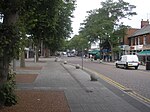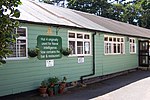Bletchley railway station

Bletchley railway station serves the southern parts of Milton Keynes, England (especially Bletchley itself), and the north-eastern parts of Aylesbury Vale. It is 47 miles (76 km) northwest of Euston, about 32 miles (51 km) east of Oxford and 17 miles (27 km) west of Bedford, and is one of the seven railway stations serving the Milton Keynes urban area.It includes junctions of the West Coast Main Line with the Bletchley-Bedford Marston Vale Line and the disused Bletchley-Oxford Varsity line. It is the nearest main line station for Bletchley Park (the World War II codebreaking centre and modern heritage attraction) and Stadium MK (the home of Milton Keynes Dons F.C).
Excerpt from the Wikipedia article Bletchley railway station (License: CC BY-SA 3.0, Authors, Images).Bletchley railway station
Buckingham Road, Milton Keynes Old Bletchley
Geographical coordinates (GPS) Address Nearby Places Show on map
Geographical coordinates (GPS)
| Latitude | Longitude |
|---|---|
| N 51.995 ° | E -0.736 ° |
Address
4
Buckingham Road
MK3 5JJ Milton Keynes, Old Bletchley
England, United Kingdom
Open on Google Maps









